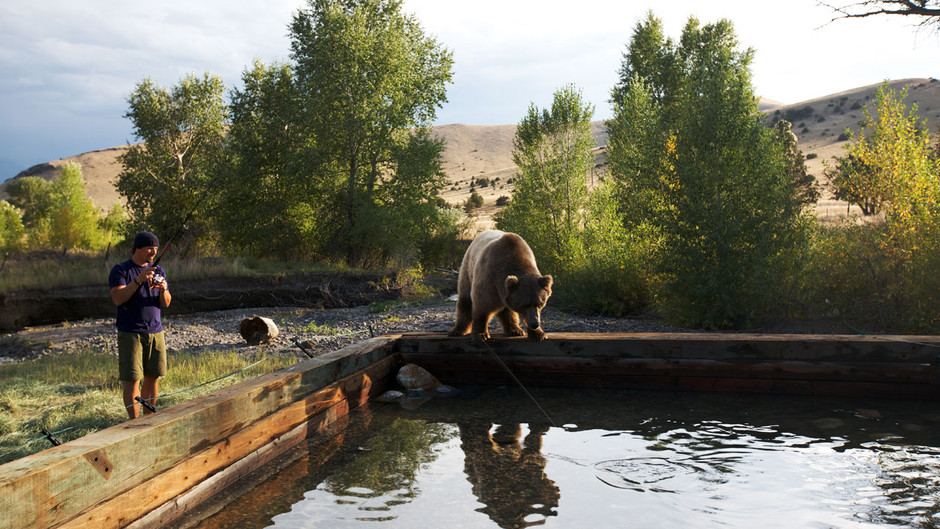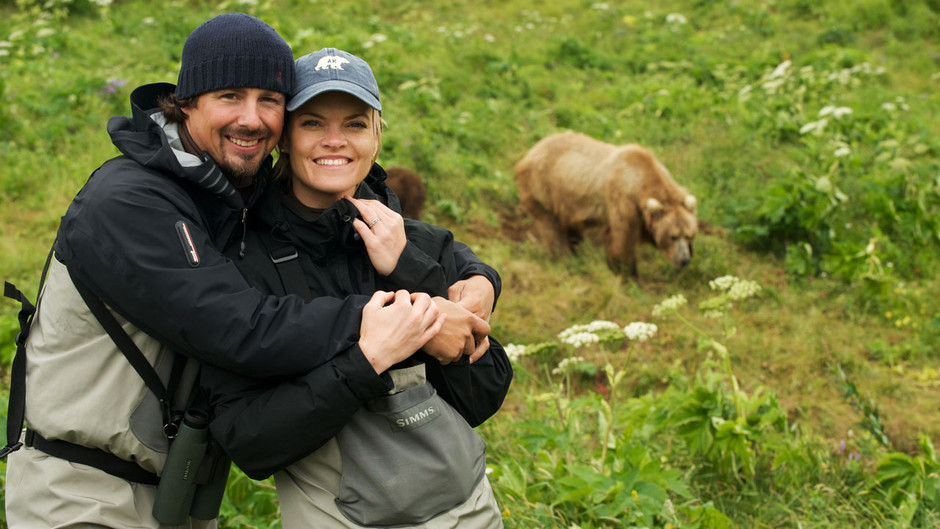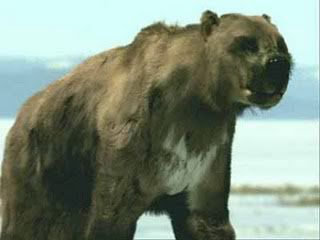Post by grrraaahhh on Jul 21, 2011 16:03:15 GMT -9

EXPEDITION KODIAK
Grizzly Bears on Kodiak Island, Alaska
* For the last 10 thousand years, since the end of the last ice age, Kodiak Island has been isolated from the mainland by the 40-kilometre wide Shelikof Strait.
* The brown bears on Kodiak Island evolved into their own unique subspecies.
* Kodiak brown bears are the biggest bears on earth.
* Kodiak Island is home to nearly thirty-five hundred bears.
* Kodiak Island has the densest concentration of brown bears anywhere in the world, with just under one bear for every 2.6 square kilometres.
* Bears in Yellowstone National Park can stand about 100 centimetres at the shoulder when on all fours and weigh about 275 kilograms.
* Coastal brown bears can stand 112 centimetres tall at the shoulder when on all fours and weigh 410 kilograms or more.
* A Kodiak bear can stand more than 140 centimetres tall at the shoulder when on all fours and weigh more than 630 kilos.
Salmon
* Salmon are important to both the human economy and the natural ecosystem of Kodiak Island.
* There are the five different species of salmon that feed Kodiak island, Pinks, Chum, Sockeye, Coho, Chinook.
* Each summer, thousands of migrating salmon in southwest Alaska pour from Naknek Lake into the Brooks River – en route to Brooks Lake a mile away.
* At the midpoint from Naknek Lake to Brooks Lake is Brooks Falls, a barrier for salmon.
* In July, southwest Alaska hosts the largest run of sockeye salmon in the world.
* A spawner count predicts the number of future offspring. This count is used to set fishing quotas that ensure a healthy population returns to spawn year after year.
* Salmon travel upstream guided by the earth’s magnetic field and the scent of their native waters.
* In Alaska, Salmon must often pass through dense bear habitat in order to arrive at their birthplace.
* Salmon have evolved into a species of nearly pure muscle capable of jumping up to three and a half metres.
* A fish ladder is a man-made structure that allows salmon to successfully ascend man-made obstacles.
* As the salmon make their brutal journey up the river, they get all beat up and they end up with all white marks all over them. And that’s what the bears look for just like a strobe light on top of their head. As they go by, they lock in on the white spots and go after them.
GRIZZLY ENCOUNTERS
Brutus the Grizzly Bear
* Brutus was born in a wildlife park in Idaho.
* Brutus weighs more than 400 kilograms.
* Standing up, Brutus is almost 2.5 metres.
* At just a few months old, there was no room left for Brutus in his home, so he was adopted by Casey Anderson.
* Like a wild bear hibernating for winter, Brutus dens in a dark, warm interior space, but has easy access to the outdoors.
Sheena
* For eighteen years, Sheena lived in a cage. She never got out of it. She never ran. She never swam. She never dug in the ground.
* Sheena’s muscles were very atrophied, in fact, she had some sores on her rear end because all she could do was sit around in this cage and stare out every day.
* The U.S. Department of Agriculture contacted Montana Grizzly Encounter to give Sheena a good home.

Casey Anderson and Brutus the bear.
Jake and Maggie
* Jake and Maggie are very different even though they are the same age.
* Maggie is very playful but a little bit more of a wallflower, a little more reserved.
* Jake is super social and very laid back.
* Jake and Maggie were initially rescued by the Wildlife Safari, near Roseburg, Oregon, but the bear exhibit was at maximum capacity.
* Jake weighs about 160 kilograms.
* Just like many of the coastal brown bears in Alaska, Jake and Maggie have a similar “long” facial profile, which contrasts with the pronounced “dish-shaped” facial profile that is often seen in Yellowstone and elsewhere in the forty-eight states.

Jake and Sheena playing. As noted, both Jake and Maggie are adopted Russian bears. The younger Jake sports two large paws - Anderson notes they are notably larger than Brutus's (now nine years old) at the same age.
Food and Play
* Brutus eats approximately sixteen kilos of food a day, and he has to because he’s still growing.
* Hiding food treats throughout the enclosure keeps the bears mentally healthy by stimulating their natural foraging instincts, which is very important in their development.
* Bears have a sweet tooth just like humans do, so it is important to check their teeth regularly because one of their biggest problems is cavities that turn into abscesses.
* In the wild, cubs that play more have a greater chance of survival.
Brutus meets Jake Video:
natgeotv.com/uk/casey-and-brutus-grizzly-encounters/videos/brutus-and-jake
YELLOWSTONE WINTER
Yellowstone National Park
* In 1872, the United States Congress created the first national park: Yellowstone.
* Yellowstone National Park is 800 thousand hectares, sheltering an ecosystem offering examples of predator-prey relationships that survive in very few places.
* Over 90% of the visitors to Yellowstone never make it off the road into the backcountry.
* The Yellowstone River is the longest un-dammed river in the lower forty-eight states, flowing 1100 kilometres from the Yellowstone backcountry, all the way down to the Missouri River.
* At the beginning of winter, most animals are going from the high country, down to the low country because of the lack of snow.
* Bears move into the high country in the beginning of winter to dig their dens and sleep for the remainder of the winter up there.
* During the winter months, the park’s higher elevations can be buried by up to 10 metres of snow.
* With the first snowfalls, massive grazing herds of elk and bison have moved in to the areas where they can still find food.
Bison
* Bison are very dangerous and actually hurt far more visitors to Yellowstone National Park than Grizzly Bears.
* Bison can attack without warning and run at speeds of up to 48 kilometres per hour.
* An adult bull bison can weigh 900 kilograms. That’s twice as much the biggest Grizzly Bear anywhere around Yellowstone National Park.
* Great herds of American bison once roamed the Plains, but humans killed an estimated forty million animals between 1800 and 1880.
* By 1900, fewer than 600 bison remained on the Plains.
* The bison the populate Yellowstone today descended from those survivors.
* In the winter, temperatures can drop far below zero, so bison take advantage of the park’s natural geothermal features, such as geysers and springs to warm themselves.
* Bison have thick coats and layers of fat to insulate them while they plough deep snow searching for food.
* In the winter at Yellowstone, deep snow hides icy rivers that can trap bison.
Mountain Lions
* A mountain lion’s claws actually are retracted into its paw when it’s walking around.
* Mountain lions or cougars like to eat deer, bighorn sheep, and elk.
* A mountain lion, when content, purrs like a house cat, and has his ears up. If he was angry, his ears would be pinned back and his eyes would be dilated.
* A mountain lion has a 4.5 metre vertical leap.
* Every part of a mountain lions body is designed to make them the perfect ambush predator. Their eyes are their keenest sense. Their long elegant body is designed for sprinting and their long legs for leaping. Their long tail helps them with their balance.
* Cougars can take down prey up to five times their weight.
Grizzly Bears
* In late November, most of the bears are tucked away in their dens for the winter. But there are still a few of them out looking for food.
* Grizzly bears in the Yellowstone area tend to excavate their dens on north facing slopes.
* During a grizzly bear’s active months, their heart rate is very much like humans, 70 to 90 beats per minute.
* During hibernation a grizzly bear’s heart rate is down to 15 beats per minute.
* A grizzly bear can keep a low heart rate for several months, but if a human were to have this same slow heart rate, they wouldn’t last.
* During the winter when food is scarce, bears slow their heart rate, breathing, and metabolism and conserve massive amounts of energy.
* A grizzly bear’s rear paw is very different from their front paw. It’s actually very similar to the sole of human feet. It is very long, which is why they stand up and their paw actually supports their weight.
* During the late summer and fall, squirrels gather massive collections of pine cones and store them in ground burrows called middens that can contain tens of thousands of nuts.
* Bears search for middens, and what they find, they raid, reaping the benefits of the huge calorie load amassed by the squirrels.
* A bear can detect a pine nut cache beneath 1.8 metres of snow.
* The part of a bear’s brain devoted to smell which is massive compared to a human brain.
* A grizzly bear can gain up to 180 kilograms during hyperphagia, the period of intense feeding before hibernation.
* Unlike many seasonal animals, bears are somewhat flexible, and hibernate when it best suits their needs.
Bighorn Sheep
* Early winter is the mating season for bighorn sheep.
* Distracted by the drive to reproduce, the sheep make an easy target for mountain lions.
* The ritual for mating season is called “the rut.”
* Rams battle for the right to breed, butting heads crowned with massive curling horns.
* When these big horns battle, they bash heads and they can exert up to 340 kilograms of impact force.
* A single conflict can last up to 20 hours, and the winning ram earns the right to mate with the most females.
* Because of the fierce competition, many males don’t breed until they are seven years old.
* To sense when a female is ready to mate, males curl their lips and take in the scent of the female over a special sensory organ.
* Even when he knows she is ready, a ram will wait for a female to chase after him before they mate.
* Bighorn sheep cling to these mountainsides to avoid mountain lions, wolves, and other predators.
* This rocky terrain is perfect for bighorn sheep to escape their predators. The bighorn sheep are very sure footed while their predators are not.
* A group of Shoshone Indians called the “sheep eater people” live in the Yellowstone region, mastering the art of hunting bighorn sheep.
* The “sheep eater people” really understood the behaviour of the sheep, and they knew when the sheep were down in the flatlands if they scared them, that they would retreat into these rocky crags for safety. They would build these pits and send hunters up to hide in them. The other hunters would walk down to the flat lands and scare the sheep. While the sheep ran up the rocks for safety, the hunters would emerge with their bows and arrows and shoot the sheep.
Prairie Rattlesnake
* Prairie rattlesnakes are the only venomous snake in the Yellowstone region.
* Snakes are cold-blooded animals.
* During the winter, they retreat to dens below the frost line where they hibernate and avoid the freezing temperatures.
* A den can have anywhere between fifty and one-thousand rattlesnakes inside of it.


natgeotv.com/uk/casey-and-brutus-grizzly-encounters

